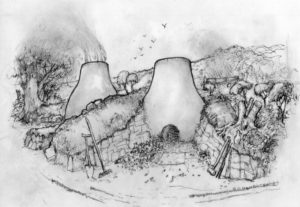Over the last 40 years or more I have lectured to more than 400 groups and societies. I can offer illustrated talks on the following subjects:

Cast-iron Firebacks
Often consigned to the dark recesses of old fireplaces, firebacks have much to reveal as social documents, through their subject matter and the people who had them made. The talk turns a potentially dull subject into a fascinating account of the history behind these pieces of iron, as well as involving the audience in some of the detective work necessary to unlock their secrets.

Iron Firebacks – A Sussex Speciality
The national predominance of the Sussex furnaces in iron production in the early-modern period, and the almost universal use of wood for domestic heating and cooking, led to the county being the principal source of iron firebacks. This talk reveals the social history and variety of these remarkable plates.

Heraldry on British Iron Firebacks
Since the Middle Ages heraldry has been the most prestigious medium of personal and corporate identity. From their introduction in the early-16th century firebacks have provided an ideal surface on which coats of arms and other heraldic devices could be displayed, though not always executed to a high degree of skill! The talk reveals their variety and the history, both personal and social, behind many of them.

Pictures in Iron: Pictorial Designs on British Firebacks
The growth of Puritanism and the influence of designs on imported continental examples led to the increasing use of pictorial illustrations on firebacks made in Britain in the 17th century and later. The talk explores the inspirations and sources for these designs, which were many and varied, and which reflected the broad cultural life of these islands.

Firebacks and Houses: Changing Styles for Changing Needs
Firebacks were a feature of fireplaces in houses in many parts of England and Wales for over 250 years, during which time their forms and styles developed, reflecting the changes in house design as well as domestic requirements and fashions. This talk will examine those changes and their context.
Wealden Iron and Church Monuments

The introduction of the blast furnace into the Weald in the late-15th century increased the availability of iron in general use, and also provided a new medium of decoration. Confined to the areas where it was produced, iron began to be used for church memorials. Less expensive or prestigious than brass or carved stone it provided the growing middle ranks of society with a durable material on which their family members could be remembered and gave distinction to those whose industry had caused the region to prosper.

The Wealden Iron Industry (from the Iron Age to the early-19th century)
Iron was made in the Weald of south east England from pre-Roman times until the beginning of the 19th century, and in the Tudor and early-Stuart periods the region was the main iron production area in the kingdom. The talk explores the raw materials, technology and historical development of the industry.

The Iron Industry in the Weald from the Iron Age to the Middle Ages
Julius Caesar noted that iron was being made in the coastal part of south east Britain. The talk explores this early activity and how the Romans exploited this natural resource, making the Weald the most productive region in the province. After a hiatus during the Saxon period, ironmaking in the Weald grew to regional importance in the Middle Ages.

The Post-medieval Iron Industry in the Weald (from 1490-1828)
The technology of the blast furnace reached England at the end of the 15th century. This talk explores how the Weald became the heart of the country’s iron industry, how guns became a significant product and how the industry was to decline under pressure of expensive raw materials and the development of new technology as the Industrial Revolution got under way.

Gun-founding in the Weald
From the late 15th century, when the blast furnace was introduced into the Weald from the Continent, gun-founding became a speciality of some of the region’s furnaces. The talk traces this development, describing the technology and the personalities involved in a trade in which the Weald was prominent until the 1760s.

The Work of the Wealden Iron Research Group
Founded in 1968, the Group set itself the task of examining the iron industry that flourished in the Weald from pre-Roman times until the early 19th century. The talk explores its discoveries, its methods and the range of the projects it undertakes.

Crawley Down – Past to nearly Present
For centuries a stretch of common land near the Sussex-Surrey border and a venue in the Regency period for prize fighting, the coming of the railway provided the impetus for the development of a village that is now home to more than 5000 people. The talk traces the key milestones of the village’s growth.
All talks are fully illustrated using photographs, contemporary paintings and documents, as well as imaginative graphical overlays and maps. By arrangement, some tailoring of talks to suit particular interests is possible; please ask.
Duration of talks:
up to 60 minutes (questions welcomed)
Equipment required:
- digital projector
- table
- screen
- electrical extension cable (I can provide this if necessary)
- small table for geological and metallurgical samples (if requested)
Fee:
£60 + travel expenses @ 25p per mile
Area:
Kent, Sussex and Surrey (further afield by arrangement)
The above talks can be delivered via ZOOM (though I prefer face-to-face)
Times:
- Weekday mornings, afternoons or evenings
- Weekend conferences
To contact me about giving a talk to your society or group CLICK HERE
You can also find me on SpeakerNet
